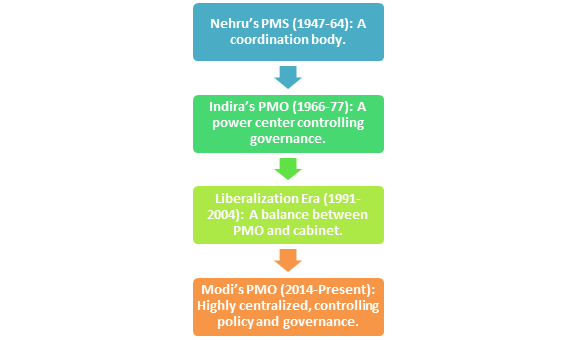About:
-
- The PMO has emerged as the key decision-making body, bypassing the cabinet and ministries.
- Key policy decisions, such as demonetization (2016), GST implementation (2017), and COVID-19 lockdown (2020), were taken with minimal consultation with cabinet or state governments.
Evolution of PMO: Coordination to centralisation

Advantages and Disadvantages of a Strong Executive
| Advantages | Disadvantages |
|---|---|
| • Enables swift decision-making, particularly in crises. • Provides policy coherence and reduces bureaucratic inefficiencies. • Enhances national and international leadership by ensuring a unified stance. | • Risks undermining democratic accountability and parliamentary oversight. • May lead to authoritarian tendencies and suppression of dissent within the government. • Reduces the role of individual ministers, leading to less diverse policy input. |
Advantages and Disadvantages of a Weak Executive
| Advantages | Disadvantages |
|---|---|
| • Encourages broader consultation and consensus-driven governance. • Strengthens parliamentary oversight and the role of individual ministers. • Reduces the risk of executive overreach and abuse of power. | • Can lead to inefficiency and slow decision-making. • May cause policy inconsistency due to competing interests within the government. • Weakens international leadership by creating uncertainty in foreign affairs. |
Way Forward
-
- Balance power by strengthening parliamentary committees
- Ensure ministers have more autonomy in decision-making.
- Increase transparency & accountability through parliamentary questions, media scrutiny, and public engagement.
- Institutional Reforms to prevent excessive centralization of power.

